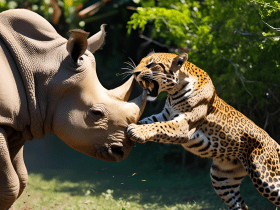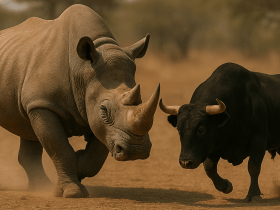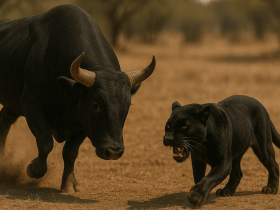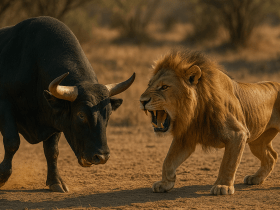Below is a full detailed article about Crocodile vs Tiger Who Wins ?
Crocodile (scientific name: Crocodylus niloticus for the Nile crocodile)
Tiger (scientific name: Panthera tigris)
Below tables cover 10 main topics by including all the numerical and scientifical data by comparing Crocodile vs Tiger Who Wins . Also I have included a winner column for further understanding, Hope you will enjoy!
1. Body Specifications
| Subtopics | Crocodile | Tiger | Winner |
|---|---|---|---|
| Height | 50-60 cm at the shoulder (when standing) | 90-110 cm at the shoulder | Tiger |
| Length | 4-5 meters (body), 1-1.5 meters (tail) | 2.5-3.9 meters (body), 0.6-1.1 meters (tail) | Crocodile |
| Weight | 225-750 kg | 90-310 kg (male), 65-170 kg (female) | Crocodile |
| Body Shape | Streamlined, armored, adapted for swimming and ambush | Muscular, agile, adapted for stealth and speed | Tie |
| Bone Density | High, adapted for strength and swimming | High, adapted for strength and agility | Tie |
| Muscle Mass | 60-70% of body weight | 70-80% of body weight | Tiger |
| Skull Size | 60-70 cm in length | 25-30 cm in length | Crocodile |
| Limb Strength | Powerful limbs for swimming and short bursts on land | Strong limbs for running and climbing | Tiger |
| Tail Function | Used for propulsion in water | Used for balance during running and climbing | Tie |
| Overall Build | Streamlined and armored, optimized for aquatic ambush | Agile and muscular, optimized for stealth and speed | Tie |
2. Skin and Coloration – Crocodile vs Tiger Who Wins
| Subtopics | Crocodile | Tiger | Winner |
|---|---|---|---|
| Color | Dark green or brown with armored scales | Orange with black stripes | Tie |
| Pattern | No distinct patterns | Stripes for camouflage | Tiger |
| Function | Camouflage in water and protection | Camouflage in forests and grasslands | Tie |
| Skin Thickness | 4-6 cm, armored with osteoderms | 1-2 cm, thick and tough | Crocodile |
| Sweat Glands | No sweat glands | Sweat glands for thermoregulation | Tiger |
| UV Protection | Relies on water for UV protection | Relies on fur for UV protection | Tie |
| Thermoregulation | Relies on water for thermoregulation | Relies on fur and sweat glands for thermoregulation | Tiger |
| Unique Features | Armored scales and osteoderms | Striped fur and retractable claws | Tie |
| Sensitivity | Sensitive to touch and vibrations | Sensitive to touch and vibrations | Tie |
| Overall Protection | Highly armored and protected | Thick skin and fur for protection | Crocodile |
3. Habitat and Range – Crocodile vs Tiger Who Wins
| Subtopics | Crocodile | Tiger | Winner |
|---|---|---|---|
| Geographic Range | Sub-Saharan Africa, Nile River | Asia (India, Siberia, Southeast Asia) | Tie |
| Habitat Type | Rivers, lakes, swamps, and estuaries | Forests, grasslands, and mangroves | Tie |
| Adaptability | Highly adaptable to freshwater and brackish environments | Highly adaptable to various environments | Tie |
| Climate Preference | Warm, tropical climates | Warm, tropical climates | Tie |
| Elevation Range | Sea level to 1,000 meters | Sea level to 3,000 meters | Tiger |
| Territorial Range | 1-10 km² | 20-400 km² | Tiger |
| Human Proximity | Can live near human settlements | Avoids human settlements | Crocodile |
| Migration Patterns | Non-migratory | Non-migratory | Tie |
| Population Density | Moderate density in suitable habitats | Low density due to solitary nature | Crocodile |
| Endemism | Found in Africa and parts of Asia | Found in Asia | Tie |
4. Diet and Hunting
| Subtopics | Crocodile | Tiger | Winner |
|---|---|---|---|
| Diet Type | Carnivorous (fish, mammals, birds) | Carnivorous (deer, wild boar, buffalo) | Tie |
| Hunting Success Rate | High, due to ambush hunting | 10-20% | Crocodile |
| Daily Caloric Intake | 1,000-2,000 calories | 5,000-7,000 calories | Tiger |
| Hunting Techniques | Ambush hunting and scavenging | Stealth, ambush, and powerful bite to the throat | Tie |
| Prey Size | Up to 10 times their body weight | Up to 10 times their body weight | Tie |
| Scavenging | Frequently scavenges | Rarely scavenges | Crocodile |
| Hunting Time | Nocturnal and crepuscular | Nocturnal and crepuscular | Tie |
| Water Dependency | High, requires water for hunting and thermoregulation | Moderate, requires regular water intake | Crocodile |
| Food Storage | No food storage | No food storage | Tie |
| Competition | Competes with lions, hyenas, and other predators | Competes with leopards, dholes, and humans | Tie |
5. Strength and Bite Force – Crocodile vs Tiger Who Wins
| Subtopics | Crocodile | Tiger | Winner |
|---|---|---|---|
| Bite Force (PSI) | 3,700 PSI | 1,050 PSI | Crocodile |
| Claw Strength | No claws, but powerful jaws | Retractable, sharp claws for gripping | Tiger |
| Lifting Capacity | Can drag prey into water | Can lift 2-3 times its body weight | Tie |
| Jaw Structure | Long, powerful jaws for crushing | Shorter, powerful jaws for suffocating prey | Crocodile |
| Neck Strength | Strong, adapted for gripping and twisting prey | Strong, adapted for supporting massive head | Tie |
| Forelimb Strength | Strong for swimming and short bursts on land | Strong for running and climbing | Tiger |
| Hind Limb Strength | Powerful for swimming | Powerful for jumping and climbing | Tiger |
| Overall Strength | Extremely powerful, adapted for aquatic ambush | Extremely powerful, adapted for stealth and speed | Tie |
| Combat Skills | Ambush-based, relies on stealth and bite force | Stealth-based, relies on ambush and agility | Tie |
| Endurance | High endurance for short bursts | High endurance for short bursts | Tie |
6. Speed and Agility
| Subtopics | Crocodile | Tiger | Winner |
|---|---|---|---|
| Top Speed | 32 km/h (on land), 20 km/h (in water) | 60-65 km/h (on land) | Tiger |
| Acceleration | Faster acceleration in water | Faster acceleration on land | Tie |
| Agility in Water | Highly agile in water | Moderate agility in water | Crocodile |
| Agility on Land | Limited agility on land | Highly agile on land | Tiger |
| Stamina | High stamina for short bursts | High stamina for short bursts | Tie |
| Jumping Ability | Limited jumping ability | Can jump up to 5 meters horizontally and 2 meters vertically | Tiger |
| Maneuverability | Highly maneuverable in water | Highly maneuverable on land | Tie |
| Reflexes | Extremely fast reflexes | Extremely fast reflexes | Tie |
| Balance | Excellent balance in water | Excellent balance on land | Tie |
| Overall Agility | Superior agility in water | Superior agility on land | Tie |
7. Senses – Crocodile vs Tiger Who Wins
| Subtopics | Crocodile | Tiger | Winner |
|---|---|---|---|
| Vision Acuity | Excellent night vision, binocular vision | Excellent night vision, binocular vision | Tie |
| Hearing Range | Can hear frequencies up to 50 kHz | Can hear frequencies up to 60 kHz | Tiger |
| Olfactory Capabilities | Highly developed sense of smell | Highly developed sense of smell | Tie |
| Whisker Sensitivity | No whiskers | Highly sensitive whiskers for navigation | Tiger |
| Depth Perception | Excellent depth perception in water | Good depth perception on land | Crocodile |
| Color Vision | Limited color vision | Limited color vision | Tie |
| Motion Detection | Highly sensitive to motion | Highly sensitive to motion | Tie |
| Low Light Vision | Superior low light vision | Superior low light vision | Tie |
| Sensory Adaptations | Adapted for nocturnal hunting | Adapted for nocturnal hunting | Tie |
| Overall Senses | Superior senses for hunting and ambush | Superior senses for hunting and ambush | Tie |
8. Reproduction and Lifespan
| Subtopics | Crocodile | Tiger | Winner |
|---|---|---|---|
| Gestation Period | 80-90 days | 90-110 days | Crocodile |
| Litter Size | 20-60 eggs | 2-4 cubs | Crocodile |
| Infant Mortality Rate | 50-70% | 30-40% | Tiger |
| Sexual Maturity | 10-12 years | 3-4 years | Tiger |
| Lifespan (Wild) | 70-100 years | 10-15 years | Crocodile |
| Lifespan (Captivity) | 70-100 years | 20-25 years | Crocodile |
| Mating System | Polygamous | Polygamous | Tie |
| Parental Care | Mother guards nest and hatchlings | Mother raises cubs alone | Tie |
| Weaning Age | 6-12 months | 6-8 months | Tie |
| Reproductive Rate | 1 clutch every 2-3 years | 1 litter every 2-3 years | Tie |
9. Social Behavior – Crocodile vs Tiger Who Wins
| Subtopics | Crocodile | Tiger | Winner |
|---|---|---|---|
| Social Structure | Solitary, except during mating or nesting | Solitary, except during mating or cub-rearing | Tie |
| Territorial Range | 1-10 km² | 20-400 km² | Tiger |
| Communication | Vocalizations, body language, and scent marking | Vocalizations, body language, and scent marking | Tie |
| Dominance Hierarchy | No strict hierarchy | No strict hierarchy | Tie |
| Cooperation | Minimal cooperation | Minimal cooperation | Tie |
| Aggression Levels | Highly aggressive when threatened | Highly aggressive when defending territory | Tie |
| Play Behavior | Hatchlings engage in play | Cubs engage in play | Tie |
| Grooming | No grooming | Self-grooming | Tiger |
| Territorial Marking | Scent marking and vocalizations | Scent marking and vocalizations | Tie |
| Overall Sociability | Solitary and independent | Solitary and independent | Tie |
10. Conservation Status – Crocodile vs Tiger Who Wins
| Subtopics | Crocodile | Tiger | Winner |
|---|---|---|---|
| IUCN Status | Least Concern | Endangered | Crocodile |
| Population Trends | Stable, but threatened in some regions | Declining due to habitat loss and poaching | Crocodile |
| Threats | Habitat loss, poaching, and human-wildlife conflict | Habitat loss, poaching, and human-wildlife conflict | Tie |
| Conservation Efforts | Protected areas, anti-poaching initiatives | Protected areas, anti-poaching initiatives | Tie |
| Legal Protection | Protected under CITES Appendix I | Protected under CITES Appendix I | Tie |
| Population Size | Estimated 250,000-500,000 | Estimated 3,900 | Crocodile |
| Genetic Diversity | Moderate genetic diversity | Low genetic diversity | Crocodile |
| Human Impact | High due to habitat loss and poaching | High due to habitat loss and poaching | Tie |
| Reintroduction Programs | Limited reintroduction efforts | Active reintroduction efforts in some regions | Tiger |
| Overall Outlook | Stable but threatened in some regions | Declining and threatened | Crocodile |
Overall Winner
- Crocodile: Wins in categories like bite force, aquatic agility, and lifespan.
- Tiger: Wins in categories like speed, agility on land, and sensory capabilities.
- Final Verdict: The crocodile has the edge in a one-on-one encounter in water due to its superior bite force and aquatic agility, but the tiger dominates on land with its speed, agility, and stealth.
References
- National Geographic: https://www.nationalgeographic.com
- IUCN Red List: https://www.iucnredlist.org
- Smithsonian’s National Zoo: https://nationalzoo.si.edu
- Journal of Zoology: Comparative studies on reptiles and mammals
- African Wildlife Foundation: https://www.awf.org
- World Wildlife Fund: https://www.worldwildlife.org
- Scientific Reports: Bite force and strength studies
- Encyclopedia Britannica: https://www.britannica.com
- San Diego Zoo Wildlife Alliance: https://animals.sandiegozoo.org
- BBC Earth: https://www.bbc.com/earth
Read More – Crocodile vs Hippopotamus : A Comprehensive Comparison






Leave a Reply